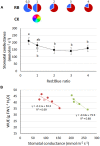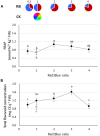Unraveling the Role of Red:Blue LED Lights on Resource Use Efficiency and Nutritional Properties of Indoor Grown Sweet Basil
- PMID: 30918510
- PMCID: PMC6424884
- DOI: 10.3389/fpls.2019.00305
Unraveling the Role of Red:Blue LED Lights on Resource Use Efficiency and Nutritional Properties of Indoor Grown Sweet Basil
Abstract
Indoor plant cultivation can result in significantly improved resource use efficiency (surface, water, and nutrients) as compared to traditional growing systems, but illumination costs are still high. LEDs (light emitting diodes) are gaining attention for indoor cultivation because of their ability to provide light of different spectra. In the light spectrum, red and blue regions are often considered the major plants' energy sources for photosynthetic CO2 assimilation. This study aims at identifying the role played by red:blue (R:B) ratio on the resource use efficiency of indoor basil cultivation, linking the physiological response to light to changes in yield and nutritional properties. Basil plants were cultivated in growth chambers under five LED light regimens characterized by different R:B ratios ranging from 0.5 to 4 (respectively, RB0.5, RB1, RB2, RB3, and RB4), using fluorescent lamps as control (CK1). A photosynthetic photon flux density of 215 μmol m-2 s-1 was provided for 16 h per day. The greatest biomass production was associated with LED lighting as compared with fluorescent lamp. Despite a reduction in both stomatal conductance and PSII quantum efficiency, adoption of RB3 resulted in higher yield and chlorophyll content, leading to improved use efficiency for water and energy. Antioxidant activity followed a spectral-response function, with optimum associated with RB3. A low RB ratio (0.5) reduced the relative content of several volatiles, as compared to CK1 and RB ≥ 2. Moreover, mineral leaf concentration (g g-1 DW) and total content in plant (g plant-1) were influences by light quality, resulting in greater N, P, K, Ca, Mg, and Fe accumulation in plants cultivated with RB3. Contrarily, nutrient use efficiency was increased in RB ≤ 1. From this study it can be concluded that a RB ratio of 3 provides optimal growing conditions for indoor cultivation of basil, fostering improved performances in terms of growth, physiological and metabolic functions, and resources use efficiency.
Keywords: Ocimum basilicum L.; energy use efficiency (EUE); land surface use efficiency (SUE); nutrient use efficiency (NUE); plant factories with artificial lighting (PFALs); water use efficiency (WUE).
Figures





References
-
- Abbas M. S. (2014). Assessment of density and cultivation type on growth and yield of two cultivars of basil (Ocimum basilicum, L.). Int. J. Agronomy Agric. Res. 5 74–79.
-
- Akiyama T., Kozai T. (2016). “Light environment in the cultivation space of plant factory with LEDs,” in LED Lighting for Urban Agriculture, ed. S. Dutta Gupta. (Singapore: Springer Nature; ), 91–109. 10.1007/978-981-10-1848-0_7 - DOI
-
- Amoozgar A., Mohammadi A., Sabzalian M. R. (2017). Impact of light-emitting diode irradiation on photosynthesis, phytochemical composition and mineral element content of lettuce cv. Grizzly. Photosynthetica 55 85–95. 10.1007/s11099-016-0216-8 - DOI
LinkOut - more resources
Full Text Sources
Research Materials
Miscellaneous

